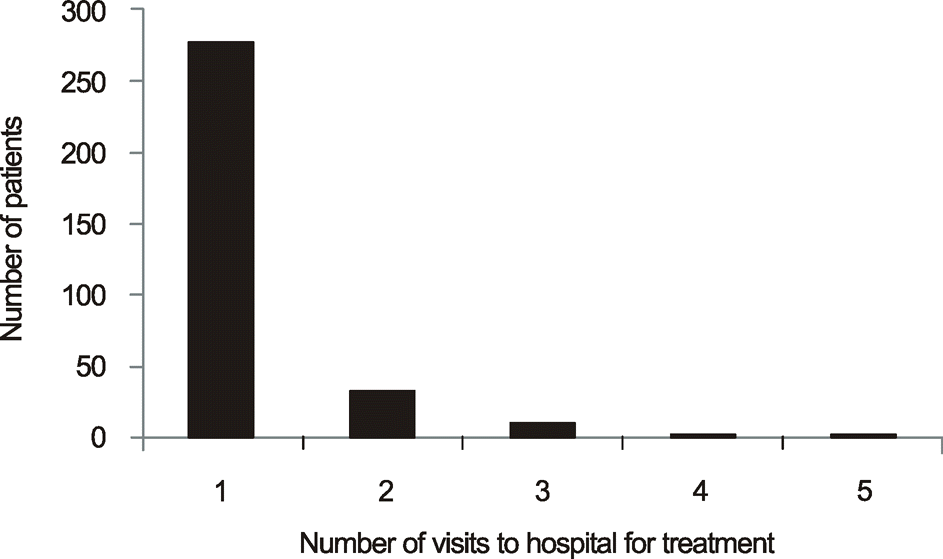Abstract
Purpose
To report the ocular health of a community after an accidental release of hydrofluoric acid (HF).
Methods
The hospital records of 327 patients that were exposed to HF between Sep 9, 2012 and Oct 31, 2012 were reviewed. Demographic characteristics, subjective ocular symptoms, and the ophthalmologic examination results of the patients were analyzed retrospectively.
Results
Among the 327 patients, 203 patients (62.1%) were exposed to hydrofluoric acid (HF) within 1,000 m of the site of the accident. A total of 131 patients (40.1%) were exposed to HF over 3 days. The most frequently reported ocular symptoms after HF exposure were ocular pain (49.5%) and conjunctival hyperemia (37.9%). Conjunctival hyperemia (43.4%), corneal erosion (23.9%), conjunctiva papilla, and follicles (24.2% and 14.4%, respectively) were noted during ophthalmologic examinations, but 46.2% of patients were normal on examination. None of the patients had vision-threatening damages.
Go to : 
References
1. Wing JS, Brender JD Sand, erson LM, et al. Acute health effects in a community after a release of hydrofluoric acid. Arch Environ Health. 1991; 46:155–60.

2. Strausburg M, Travers J, Mousdicas N. Hydrofluoric acid ex- posure: a case report and review on the clinical presentation and management. Dermatitis. 2012; 23:231–6.
3. Burgher F, Mathieu L, Lati E, et al. Experimental 70% hydrofluoric acid burns: histological observations in an established human skin explants ex vivo model. Cutan Ocul Toxicol. 2011; 30:100–7.
4. Anderson WJ, Anderson JR. Hydrofluoric acid burns of the hand: mechanism of injury and treatment. J Hand Surg Am. 1988; 13:52–7.

5. McCulley JP, Whiting DW, Petitt MG, Lauber SE. Hydrofluoric acid burns of the eye. J Occup Med. 1983; 25:447–50.

6. Matsumoto S. [Hydrofluoric acid burn: particulars on multiple pul- monary thrombi]. J UOEH. 1989; 11:411–24.
7. Tsonis L, Hantsch-Bardsley C, Gamelli RL. Hydrofluoric acid in- halation injury. J Burn Care Res. 2008; 29:852–5.
8. Tepperman PB. Fatality due to acute systemic fluoride poisoning following a hydrofluoric acid skin burn. J Occup Med. 1980; 22:691–2.

9. Bron AJ, Evans VE, Smith JA. Grading of corneal and conjunctival staining in the context of other dry eye tests. Cornea. 2003; 22:640–50.

10. Roh YR, Lee SM, Han YK, et al. Changes in clinical manifes- tations of dry eye syndrome after cataract surgery and the affecting factors. J Korean Ophthalmol Soc. 2011; 52:1030–8.
11. Makarovsky I, Markel G, Dushnitsky T, Eisenkraft A. Hydrofluoride –the protoplasmic poison. Isr Med Assoc J. 2008; 10:381–5.
12. Perry HE. Pediatric poisonings from household products: hydro- fluoric acid and methacrylic acid. Curr Opin Pediatr. 2001; 13:157–61.
15. Upfal M, Doyle C. Medical management of hydrofluoric acid exposure. J Occup Med. 1990; 32:726–31.
16. Beiran I, Miller B, Bentur Y. The efficacy of calcium gluconate in ocular hydrofluoric acid burns. Hum Exp Toxicol. 1997; 16:223–8.

17. Dünser MW, Rieder J. Images in clinical medicine. Hydrofluoric acid burn. N Engl J Med. 2007; 356:e5.
Go to : 
 | Figure 1.Presentation time (in days) of cases to hospital after hydrofluoric acid release. Note that Day 2, 3, 4, and 6 were national holidays in the Republic of Korea. |
Table 1.
Demographic characteristics of visited patients after accidental release of hydrofluoric acid
Table 2.
Distance from chemical plant and exposure time to hydrofluoric acid
Table 3.
Ocular symptoms after exposure to hydrofluoric acid
| Symptoms | Number of responses (multiple responses) |
|---|---|
| Ocular pain | 162 |
| Foreign body sensation | 88 |
| Itching sensation | 33 |
| Tearing | 61 |
| Hyperemia | 124 |
| Decreased vision | 0 |




 PDF
PDF ePub
ePub Citation
Citation Print
Print




 XML Download
XML Download